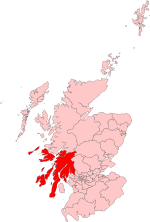Sgat Mòr and Sgat Beag

Sgat Mòr and Sgat Beag (Scottish Gaelic pronunciation: [s̪kat̪ moːrˠ ɪs̪ s̪kat̪ pɛk]; English: The Skate Islands or, less commonly, Skate Island and Wee Skate Island) are two small islands that lie at the mouth of Loch Fyne by the shore of the Cowal peninsula on the west coast of Scotland. Sgat Mòr lies at grid reference NR930666 directly south of Eilean Aoidhe and rises just 11 metres (36 ft) above sea level. Sgat Beag is a similar but slightly smaller island that lies approximately 1 kilometre to the east, across the mouth of Asgog Bay. The islands appear to have been named after the Skate fish however there is a Skate Point and Skate Bay on nearby Great Cumbrae so it is not impossible that skate is a local toponym with a different derivation. The channel between Sgat Mòr and the Cowal shoreline at Eilean Aoidhe is navigable and local sailing regattas, paddle steamer Waverley and MV Balmoral regularly pass inside this narrow channel. The waters to the south of the islands are the deepest in the Clyde area.A beacon resembling a small lighthouse is situated on the southwestern shore of Sgat Mòr.
Excerpt from the Wikipedia article Sgat Mòr and Sgat Beag (License: CC BY-SA 3.0, Authors, Images).Sgat Mòr and Sgat Beag
Geographical coordinates (GPS) Address Nearby Places Show on map
Geographical coordinates (GPS)
| Latitude | Longitude |
|---|---|
| N 55.84805 ° | E -5.30821 ° |
Address
Low Stillaig
PA21 2DA
Scotland, United Kingdom
Open on Google Maps











